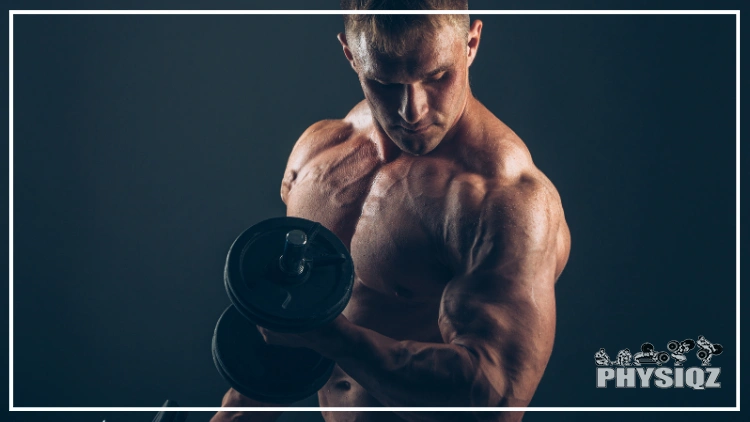
For people wondering what muscles work during curling, bicep curling is a popular exercise used to target the bicep muscles but there’s actually several muscles that make up the bicep.1
The primary muscle worked by this exercise is the biceps brachii, which are located on the front of each upper arm. Additionally, other muscles such as the brachialis, brachioradialis, and forearm flexors will be engaged during this movement.
However, some individuals may not grasp the distinct heads of the biceps or utilize them effectively, resulting in concerns about having poor arm genetics or bad bicep genetics.
That being said, there are three types of bicep curls that all lifters should perform to maximize growth from curling and each is covered below.
The Anatomy & Mechanisms of the Bicep Muscles (Long Head vs Short Head vs Brachialis)
When it comes to the muscles that work during curling, three main parts of the upper arm contribute to the movement: the long head of the bicep, the short head of the bicep, both of which are known as the biceps brachii, and the brachialis.
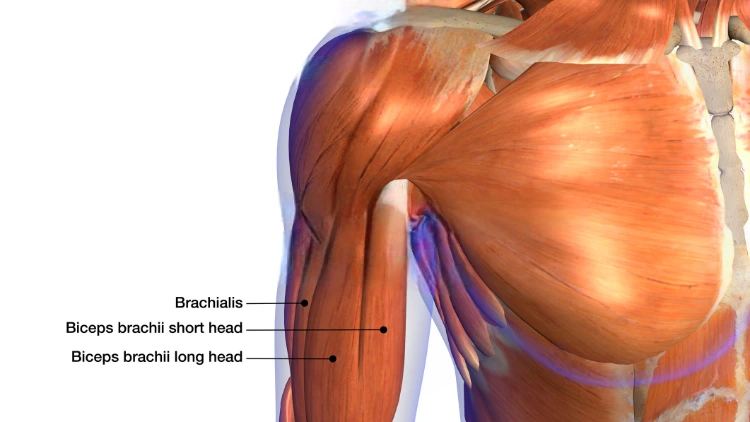
Source: Hank Grebe via Canva.com2
Long Head of the Bicep
The long head inserts at the elbow joint and originates from the supraglenoid tubercle, which is essentially on the outside of the shoulder joint, near where the lateral deltoid is.3 Its main function is to perform internal rotation of the arm, as well as to pull the arm away from the body (imagine doing a jumping jack).
Short Head of the Bicep
The short head of the bicep similarly inserts at the elbow joint, but it instead originates from the apex of the coracoid process of the scapula, ever so slightly to the right of the origin point of the long head. To keep things simple, it essentially inserts at the shoulder joint.
Regardless, many people assume that the short head of the bicep performs the same function as the long head – but that simply is not the case.
The short head performs arm adduction, pulling the arm back towards the body, which is opposite to the long head, as well as performing external rotation of the forearm.
At the same time, keep in mind that a contraction of both the long and short heads will result in arm flexion, which is essentially what a curl does.
Brachialis
The brachialis resides underneath the biceps brachii heads, originating from the distal anterior humerus and inserting onto the ulnar tuberosity.4
In layman’s terms, it originates underneath where the deltoid originates and inserts near the elbow, and its sole function is to perform flexion of the forearm at the elbow joint, operating as one of the largest elbow flexors.5
When it comes to providing the greatest overall size in the upper arm, both heads of the biceps brachii and the brachialis are very important, but ultimately, the short head accounts for the width of the bicep, the long head accounts for the height, and the brachialis adds some extra height and density from underneath.
Meaning, focusing on training the long head of the bicep is best to train for having a high bicep peak.One small fact to note — the picture above shows the two heads of the biceps brachii, the brachialis, and a fourth muscle — the coracobrachialis.6
Although it has a similar name to the brachialis, its main function is to flex and adduct the arm at the shoulder, but it does not significantly contribute to curling.
What Muscles Does the Bicep Curl Work?
When it comes to what muscles work with curling, three main groups are used to flex at the elbow joint to curl the weight up: the biceps brachii, the brachialis, and the forearms. Given that curls target similar muscles as pull-ups and pulldowns, the muscles worked in close grip lat pulldowns are largely the same.
Long & Short Heads of the Biceps (Biceps Brachii)
The biceps brachii consists of two heads that originate from different parts of the shoulder joint and insert into the elbow joint. Both heads, when contracted, generate flexion at the elbow joint and moves the weight up.
This is why the biceps are the primary mover in the curl. Since they are the main muscle that leads to elbow flexion, they bear the majority of the weight in the bicep curl, so for those aiming to develop larger or stronger biceps, performing specific types of curls makes a lot of sense.
Brachialis
As mentioned above, the brachialis resides underneath the biceps brachii in the arm and also helps to perform elbow flexion. Traditional bicep curling, where the arm is supinated (facing upward), tends to elicit more bicep activation since the long head of the bicep is used to rotate the arm.
This means that intuitively, performing a curl variation like the hammer curl would be better to target the brachialis. Having a neutral grip would lead to overall less bicep and more brachialis activation.
Keep in mind, though, that while this is a frequently agreed-upon principle when it comes to what muscles work in curling, there is no actual research that displays various EMG (electromyography) muscle activation with different curl variations, so it is difficult to definitively say if this assumption is correct.
Forearms (Brachioradialis, Forearm Extensors, Wrist Extensors)
The forearms are where things get a bit messy. There are 20 different forearm muscles that exist, with some existing to assist in elbow flexion, some existing to perform wrist flexion, and others existing to help provide grip strength.
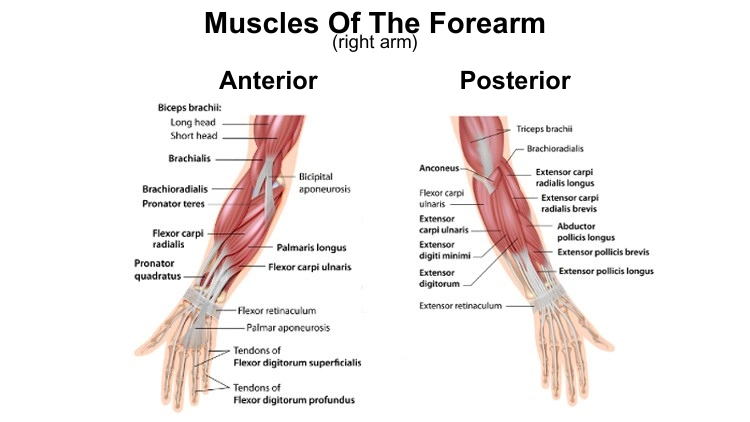
Source: Alila Medical Media on Shutterstock7
They are broken up into two groups: flexors and extensors, with each group being further subdivided into superficial and deep muscles. The superficial flexors include the:
- Pronator teres
- Flexor carpi radialis longus
- Palmaris longus
- Flexor carpi ulnaris
- Flexor digitorum superficialis
The deep flexors which exist underneath the superficial flexors include the:
- Pronator quadratus
- Flexor digitorum profundus
- Flexor pollicis longus
The forearm extensor muscles make up 12 of the 20 forearm muscles, with the superficial extensors being the:
- Brachioradialis
- Extensor carpi radialis brevis
- Extensor carpi radialis longus
- Extensor carpi ulnaris
- Extensor digitorum
- Extensor digiti minimi
- Anconeus
And last but not least, the deep extensor muscles of the forearm are the:
- Abductor pollicis longus
- Extensor pollicis longus
- Extensor pollicis brevis
- Extensor indicis
- Supinator
All in all, any bicep curl variation will force a weightlifter to grasp the weight in their hands and flex their forearm muscles in order to grip it. This means that the forearms are more of a secondary mover when it comes to performing a bicep curl.
One other caveat to note is that the brachioradialis has shown to have significantly more activation when using a reverse grip when performing a bicep curl, meaning using a pronated grip (hands facing down) when doing a bicep curl will make the forearms more of a primary mover.
Shoulders (Front Deltoid)
The shoulder was not mentioned in the intro to this section for one main reason: a properly performed bicep curl should barely activate them.
Sometimes, such as when people question if curling 40-pound dumbbells is beneficial, excessive momentum or poor form may engage the shoulders slightly to assist in swinging the weight up.
This means using heavier weights — like 40 pounds — may mean that a lifter is using excessive momentum to get the weight up, ultimately taking the strain off the bicep.
Or, in other cases, where the elbows drift forward rather than stay pinned to the sides, the shoulder may be activated since it is slightly stretched from the elbow movement.
That being said, the shoulders have a negligible effect on the amount of weight that can be lifted when performing a bicep curl.
Different Curling Grips & Arm Positions Effect on Muscles Worked When Curling
The main way to modulate what muscles are being activated when curling is by adjusting the curl grip, typically done by adjusting arm width or rotation.
In general, though, adjusting arm positioning when curling tends to have a negligible impact on the muscles worked, but some people may feel that they get better recruitment with certain grip widths or arm rotation.
Underhand Curls (Supinated) Emphasizes the Biceps Brachii
When a person envisions a bicep curl in their head, whether with a standard barbell, dumbbells, or an EZ bar, the hands typically face up towards the ceiling. This is known as a supinated bicep curl, where the arm is rotated externally.
This bicep curl variation is the bread-and-butter of any routine that involves bicep work, and as such, it does exactly what one would expect it to do — it prioritizes training of the biceps brachii itself.
Of course, by default, it will train the forearm flexors and the brachialis in the upper arm, but for the most part, a supinated bicep curl targets the biceps brachii.
Overhand or Reverse Curls (Pronated) Emphasizes the Brachioradialis
The muscles engaged in reverse curls have a distinct emphasis compared to the standard supinated bicep curl.
A reverse curl is where the arm is internally rotated with the hands facing toward the floor, opposite of the standard supinated curl. This is arm pronation.
When the arms are pronated, while the reverse curl will still activate the biceps brachii and brachialis, a large amount of tension that was once placed upon the bicep directly is now being re-routed to the forearms, or more specifically, the brachioradialis.
Switching to a pronated bicep curl makes the movement entirely different overall, and is much better suited to those whose main goal is to make forearm gains rather than bicep gains.
Of course, using a variety of bicep curls is optimal for overall arm growth, but reverse curls are an exercise that targets the forearms with a lot of overhead room for progressive overload.
Neutral Grip or Hammer Curls Emphasizes the Brachialis
As mentioned above, it is widely agreed upon in the fitness community that a neutral grip is the best grip for activating the brachialis when performing a bicep curl.
But for whatever reason, there has never been a study published that specifically looks at brachialis activation when performing bicep curl variations.
In other words, there is no data to back up the claim that the hammer curl is the superior version of the bicep curl to target the brachialis.
That being said, sometimes, bro science is right. Bodybuilding champions like Mike O’ Hearn and Arnold Schwarzenegger are proponents of the hammer curl for brachialis growth.
Obviously, we can’t just say that they are correct because they had incredible bodies at their respective peaks, but it does suggest that the hammer curl is worth trying.
Wide Grip Curls Emphasize the Short Head of the Biceps
As mentioned above, the short head of the biceps brachii helps contribute to arm adduction, referring to internal and external rotation at the elbow joint. With a wider-than-shoulder-width grip on the bar, the bicep curl becomes slightly more focused on the short head of the biceps due to this fact.
Narrow Grip Curls Emphasize the Long Head of the Biceps
Similarly, since a wide grip targets the short head of the biceps more, it would make sense for a narrower grip to target the long head more. That is the case — thinking back to what was discussed above, internally rotating the forearm, towards the body, causes more long head activation, so it makes sense for a narrower curl to emphasize the long head of the biceps.
Curls With Elbows by Your Side Don’t Emphasize Any Particular Muscle
Performing a bicep curl with elbows at the sides does not substantially affect the muscles that work during curling, but keeping the elbows locked into place with little swinging of the arms will force the biceps to take on the majority of the work.
Assuming the curl is performed with little arm rotation, there is not even an emphasis on which bicep head is targeted more than the other.
All of this is to say, if a person desires to work their biceps without targeting one head over the other, performing a supinated bicep curl with elbows at the sides is likely optimal for growth.
Curls With Elbows in Front of You Emphasizes the Short Head of the Biceps
Last but not least, performing a bicep curl with elbows in front of the body will inevitably target the short head of the bicep more than the long head. With the elbows in front of the body, the biceps are heavily stretched, but there is also a greater range of motion required to curl the forearms back toward the body.
As mentioned earlier when discussing the anatomy of the biceps, the short head is responsible for bringing the arm back toward the body, making a bicep curl with elbows further from the body good for targeting the short head of the biceps. This anatomy also explains why the trap bar deadlift muscles worked involve the biceps — as the elbows are positioned in front of the body, the pulling action brings them back toward it.
Should I Do Curls With Dumbbells, a Barbell, an EZ Bar, or Curling Machines?
Performing bicep curls with a variety of resistances, meaning using dumbbells, barbells, and machines is best for targeting all muscles used when performing a bicep curl.
But, there has been research conducted to compare what muscles are activated most between the dumbbell curl (DC), traditional barbell curl (BC), and the EZ bar curl (EZ).
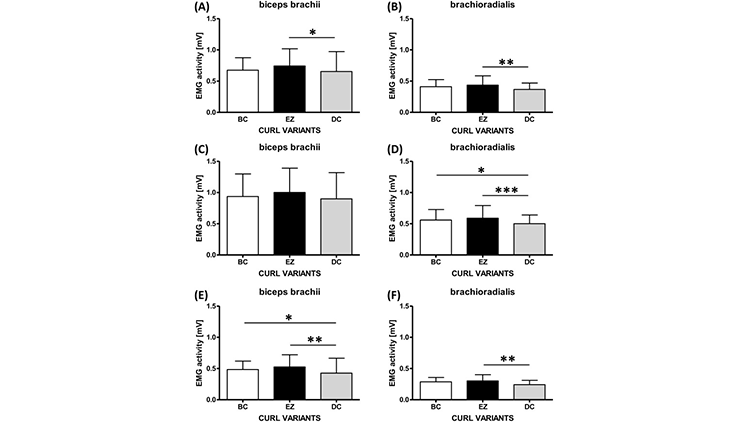
EMG activity of the biceps brachii and brachioradialis during (A–B) the whole range of motion, (C–D) the concentric phase, and (E–F) the eccentric phase (C). (∗p < 0.05, ∗∗p < 0.01).8
The EMG data shows that throughout the entirety of the movement, in figures A and B, the EZ bar curl shows slightly more activation in both the biceps and the main forearm flexor, the brachioradialis.8
The same can be said for both the concentric phase (figures C and D) and the eccentric phase (figures E and F), although at a certain point, the differences in muscle activation are negligible.
Regardless, this suggests that performing bicep curls with an EZ bar is optimal for activating the arm musculature maximally.
Although, keep in mind that brachialis activation was not recorded in this study, so it is difficult to objectively conclude whether one variation was better than another in that case.
What Muscles Work During Barbell Curls vs Dumbbell Curls?
As seen in the above study, it seems that the barbell curl activates both the biceps brachii and the brachioradialis to a similar level that the dumbbell curl does.
Since the dumbbell curl requires each hand to unilaterally hold a weight, certain stabilizer muscles in the shoulder will likely be activated (based on shoulder rotation) more than in the regular barbell curl, and the same can be said for forearm flexors that may not need to be activated as much when a singular bar is being gripped by both hands.
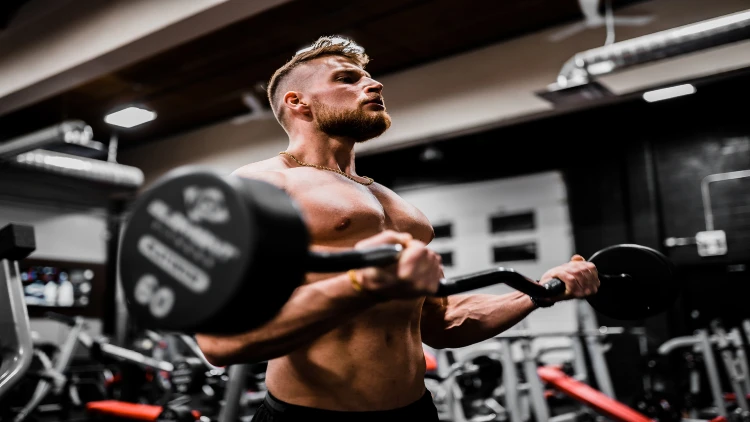
Photo by Anastase Maragos on Unsplash9/a>
Current research suggests that unilateral training can be highly beneficial to include as part of a training program in general.10
Not only does unilaterally training a muscle group contribute to increased neuromuscular performance, likely due to the increased stability requirements of training unilaterally, but unilateral exercise also seems to increase strength in bilateral movements, and more specifically, in stabilizer muscles that are underutilized.
This is to say — training the bicep curl with dumbbells can be highly beneficial for reasons other than wanting to switch up the curl variation a lifter is performing.
The 3 Best Curl Variations To Target All Bicep Heads & How To Do Them With Good Form
The best curl variations to target the different bicep heads can be inferred based on the above information, but let’s name them specifically to make things easy.
1. Hammer Curls To Target the Brachialis
As mentioned twice above, hammer curls are performed with a neutral grip and dumbbells and, based on what many bodybuilders say, are fantastic for targeting the brachialis, helping to develop the overall width of the arm.
Although there isn’t conclusive research to support this assessment, anecdotal evidence would suggest this is accurate, so give hammer curls a try.
To perform a hammer curl properly, stand tall with shoulders locked back and down, the core tight, and the glutes flexed to ensure there is no swinging. With dumbbells held in a neutral grip at the sides, contract the bicep and raise the dumbbells until just past parallel to the floor.
More range of motion beyond this is unnecessary and just takes the emphasis off of the bicep and brachialis. Lower the dumbbells slowly, imagining that the weight is dragging the forearm down; this will help to develop a better mind-muscle connection with the upper arm.
2. Incline Curls To Target the Bicep Long Head
Incline curls are performed on a bench with either a 30 or 45-degree incline. This forces the elbows to be placed behind the body, stretching the bicep, and more specifically, forcing the long head to be stretched to a greater extent.
This stretch makes the long head take over as the primary bicep head is activated when performing an incline curl.
Performing an incline curl is as easy as what is said above. Set up a bench with a 30 or 45-degree incline and place two dumbbells on the floor, one at each side.
Sit on the bench and reach down to grab the dumbbells, leaning back and letting the hands fall to the side. There should already be a great stretch at the bottom portion of the movement here.
Since the incline curl already targets the long head of the bicep, pick a supinated or neutral grip to ensure that the focus is kept on it, and curl the arms while keeping the elbow relatively still.
Similar to the hammer curl, curling too far beyond parallel will just take the emphasis off of the biceps, and the lowering phase is the exact same — slow and controlled.
3. Preacher Curls To Target the Bicep Short Head
Preacher curls were already mentioned above as a great way to target the short head of the bicep, and they are arguably the best bicep curl variation to do so. Anyone who has performed the preacher curl would agree that the contraction and stretch felt from the preacher is unparalleled when it comes to curls.
To perform a preacher curl, the majority of the work is done by the time a lifter gets to the preacher curl bench. Before grabbing the bar, sit down on the seat and lift the arms forward, placing the elbows as far forward on the arm pad as possible.
The goal is to have the armpits locked into place on the arm pad; this will reduce the ability to swing or bring the shoulders into play.
Once the seat is adjusted to a proper height to make this the case, lower the arms completely to grab the bar and use some momentum to get the bar up for the first rep.
From here, each rep should look the same — slow and controlled eccentric, letting the forearms fall back to the starting position to get a maximal stretch, then contracting the bar back up to above the shoulders.
Sample Curl Workout Plan for Arm Day
For a bicep-targeted arm workout, there is going to be a lot of volume. The biceps can take a lot of volume, in general, before they are completely exhausted, so targeting a high amount of repetitions with lighter weights is the priority here.
Still, the biceps aren’t the toughest muscle to grow — it just requires persistence.
But, the start of the workout will focus a bit more on strength with heavier weight and lower reps on the standard barbell curl, then follow it up with preacher curls and hammer curls later in the session to target different parts of the upper arm.
Bicep-Focused Arm Day Workout
- Barbell Curl: 3×6-8, 2-3 minutes rest
- Barbell Skullcrushers: 3×10-12, 2-3 minutes rest
- Preacher Curls (DB or Barbell): 4×10-12, 1-2 minutes rest
- Rope Pushdowns: 4×12-15, 1-2 minutes rest
- Hammer Curls: 4×12-15, 1-minute rest maximum
When it comes to what muscles work in curling, performing a bicep curl with different grip widths, arm rotations, and tinkering with elbow placement are all good ways to modulate what muscles are targeted most throughout the range of motion.
Frequently Asked Questions
How Do I Fix Elbow or Wrist Pain From Curling?
For people who are concerned about “why does my forearm hurt when I curl”, a bicep curl wrist twitch is ultimately a separate issue from curling. When there is elbow or wrist pain when curling, more often than not, the root cause is an overworked forearm that, when forced to grip a weight, overly tightens and causes pain in one of the joints, so stretching the forearm will typically resolve the problem.
Are Compound Exercises or Isolation Exercises Better for the Biceps?
Compound exercises like the chin-up are fantastic for overloading the biceps with quite a bit of weight, more than is possible in an isolation exercise. But, biceps typically respond better to higher repetitions, meaning a combination of chin-ups and high-repetition bicep curls, for example, would be a good way to develop strength and size in the biceps.
What Are the Benefits of Curls?
The main benefits of bicep curls are increased arm width, overall arm thickness, and a bit of carryover to pulling exercises like the row and chin-up.
What Mistakes Should I Avoid When Curling?
One mistake that many people tend to make when performing the bicep curl is to use way too much momentum to get the weight up, swinging the elbows forward. If a lifter has to do this to get the weight up on every single repetition, the weight is simply too heavy — dropping the weight and focusing on solely contracting the bicep to raise the weight should be the goal when curling.
References
1Satyrenko. Canva. Accessed 20 April 2023. <https://www.canva.com/photos/MADA01hZUJg-muscle-man-doing-bicep-curls/>
2Grebe, Hank. Canva. Accessed 20 April 2023. <https://www.canva.com/photos/MADZASGJL7w-labeled-anatomy-chart-of-neck-and-shoulder-muscles-on-white-background/>
3Contributors to Wikimedia projects. (2023, January 11). Biceps. Wikipedia. <https://en.wikipedia.org/wiki/Biceps>
4Contributors to Wikimedia projects. (2023, January 13). Brachialis muscle. Wikipedia. <https://en.wikipedia.org/wiki/Brachialis_muscle>
5Plantz, M. A., & Bordoni, B. (2022, February 22). Anatomy, shoulder and upper limb, brachialis muscle. NCBI Bookshelf. <https://www.ncbi.nlm.nih.gov/books/NBK551630/>
6Contributors to Wikimedia projects. (2023, January 13). Coracobrachialis muscle. Wikipedia. <https://en.wikipedia.org/wiki/Coracobrachialis_muscle>
7Alila Medical Media. “Muscles Forearm Anterior Posterior View Stock Illustration 147943889.” Shutterstock. Accessed 20 April 2023. <https://www.shutterstock.com/image-illustration/muscles-forearm-anterior-posterior-view-147943889>
8Marcolin, G., Panizzolo, F. A., Petrone, N., Moro, T., Grigoletto, D., Piccolo, D., & Paoli, A. (2018). Differences in electromyographic activity of biceps brachii and brachioradialis while performing three variants of curl. PeerJ, 6. <https://doi.org/10.7717/peerj.5165>
9Maragos, Anastase. “topless man in black shorts carrying black dumbbell photo – Free Fitness Image on Unsplash.” Unsplash, 6 February 2020. Accessed 20 April 2023. <https://unsplash.com/photos/7kEpUPB8vNk>
10Appleby, B. B., Cormack, S. J., & Newton, R. U. (2019). Specificity and transfer of lower-body strength: Influence of bilateral or unilateral lower-body resistance training – PubMed. Journal of Strength and Conditioning Research, 33(2). <https://doi.org/10.1519/JSC.0000000000002923>